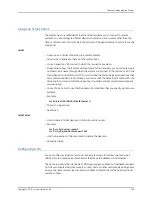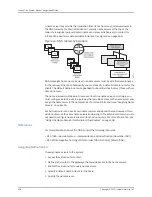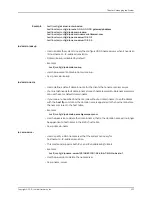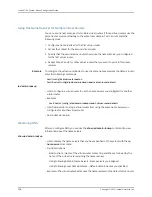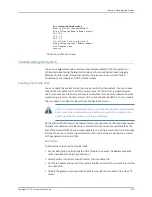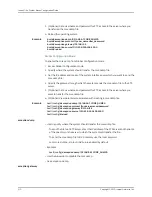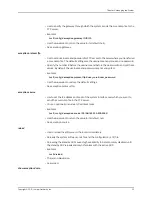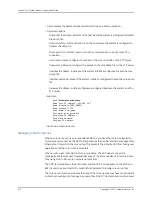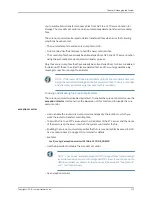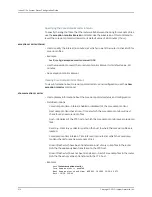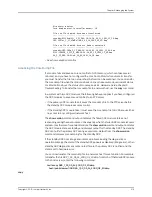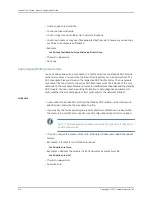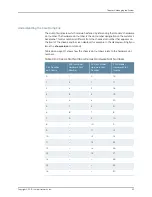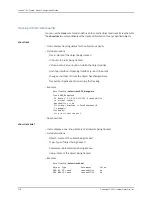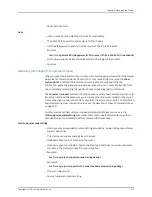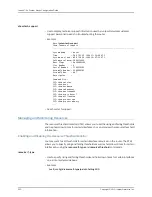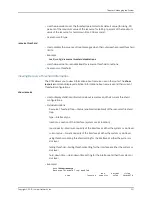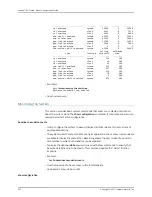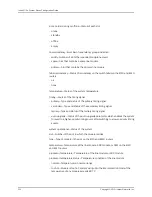
host1#
show ip domain-lookup
Bind to client: (boston)default
Using following Domain Name Servers:
10.2.0.3
11.1.1.1
10.1.1.1
1:2:3:4:5:6:7:8:9:0:a:b:c:d:e:f
Using following Local Domain Names :
urlofinterest.com
concord
•
See show ip domain-lookup.
Troubleshooting the System
You can use
log
commands to discover and isolate problems with the system. For
information about using the
log
commands, see the
JunosE System Event Logging
Reference Guide
. Juniper Networks Customer Service can use core dump files to
troubleshoot line module and SRP module failures.
Creating Core Dump Files
You can enable the system to create a core dump file if a module fails. You can choose
to send the core dump file to an FTP server or save the file to NVS. Juniper Networks
Customer Service can then access the core dump file and analyze it to determine what
went wrong. Local core dumps—stored in NVS—are enabled by default. You can enable
the core dump from Boot mode or Global Configuration mode.
CAUTION:
Create a core dump file only under the direction of Juniper Networks
Customer Service. Network function can be disrupted if you create a core
dump file while the system is running in a network.
On the E120 and E320 routers, the failure of some components on a line module generates
multiple core dumps to provide more complete information about system state at the
time of the failure. Other E Series routers generate only a single core dump for line module
failures. When you contact Juniper Networks Customer Service for assistance, send all
of the generated core dump files.
Boot Mode
To enable the core dump from Boot mode:
1.
Access Boot mode by reloading the SRP module; then press the
mb
key sequence
(case insensitive) during the countdown.
2.
Specify where the system should transfer the core dump file.
3.
Set the IP address and mask of the system interface over which you want to send the
core dump file.
4.
Specify the gateway through which the system sends the core dump file to the FTP
server.
309
Copyright © 2010, Juniper Networks, Inc.
Chapter 5: Managing the System
Summary of Contents for JUNOSE 11.3
Page 6: ...Copyright 2010 Juniper Networks Inc vi...
Page 8: ...Copyright 2010 Juniper Networks Inc viii JunosE 11 3 x System Basics Configuration Guide...
Page 24: ...Copyright 2010 Juniper Networks Inc xxiv JunosE 11 3 x System Basics Configuration Guide...
Page 32: ...Copyright 2010 Juniper Networks Inc 2 JunosE 11 3 x System Basics Configuration Guide...
Page 146: ...Copyright 2010 Juniper Networks Inc 116 JunosE 11 3 x System Basics Configuration Guide...
Page 166: ...Copyright 2010 Juniper Networks Inc 136 JunosE 11 3 x System Basics Configuration Guide...
Page 432: ...Copyright 2010 Juniper Networks Inc 402 JunosE 11 3 x System Basics Configuration Guide...
Page 488: ...Copyright 2010 Juniper Networks Inc 458 JunosE 11 3 x System Basics Configuration Guide...
Page 524: ...Copyright 2010 Juniper Networks Inc 494 JunosE 11 3 x System Basics Configuration Guide...
Page 554: ...Copyright 2010 Juniper Networks Inc 524 JunosE 11 3 x System Basics Configuration Guide...
Page 566: ...Copyright 2010 Juniper Networks Inc 536 JunosE 11 3 x System Basics Configuration Guide...
Page 588: ...Copyright 2010 Juniper Networks Inc 558 JunosE 11 3 x System Basics Configuration Guide...
Page 613: ...PART 3 Index Index on page 585 583 Copyright 2010 Juniper Networks Inc...
Page 614: ...Copyright 2010 Juniper Networks Inc 584 JunosE 11 3 x System Basics Configuration Guide...
Page 632: ...Copyright 2010 Juniper Networks Inc 602 JunosE 11 3 x System Basics Configuration Guide...











